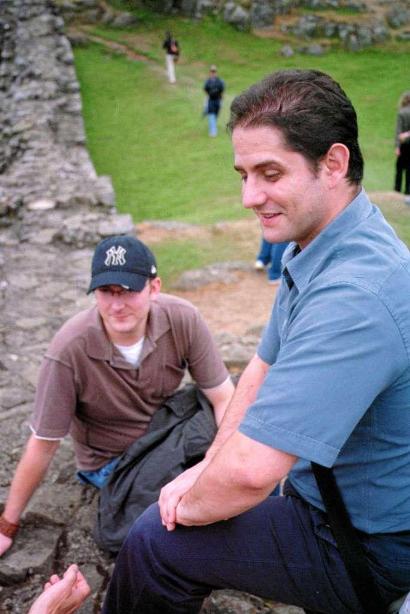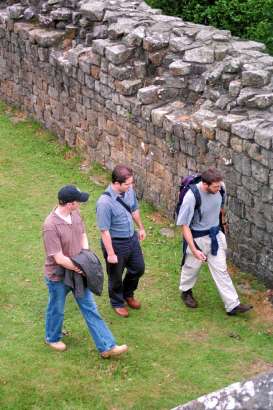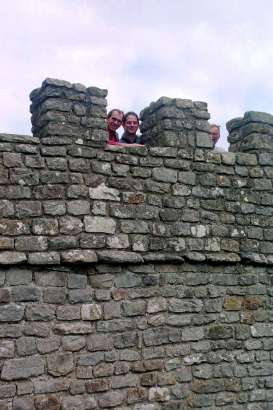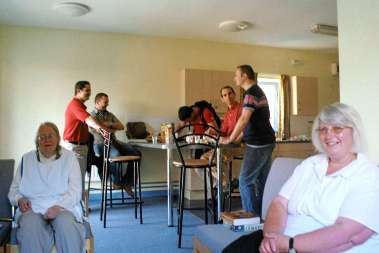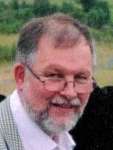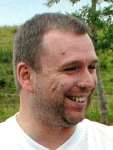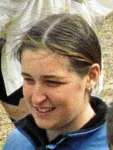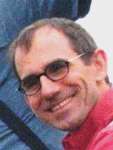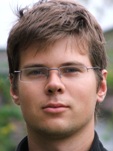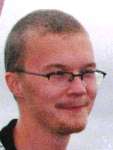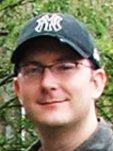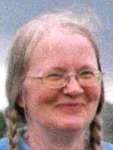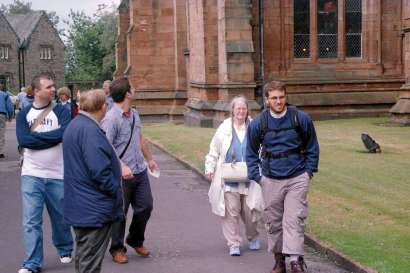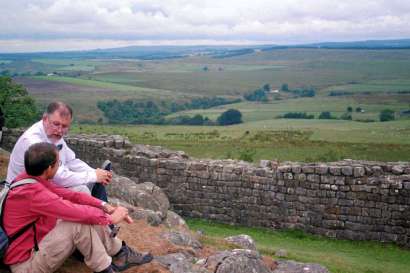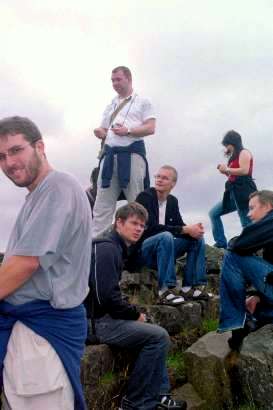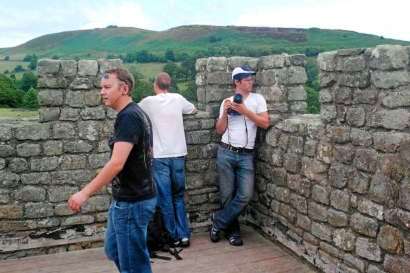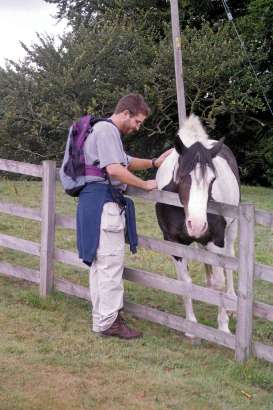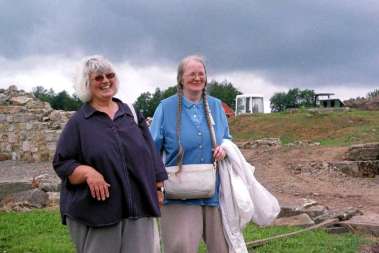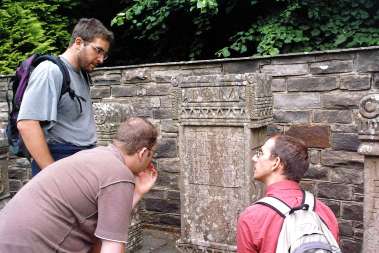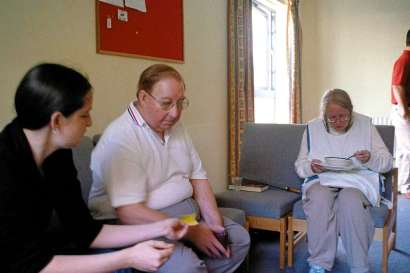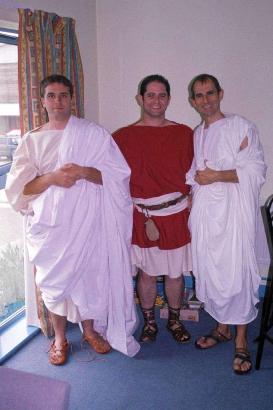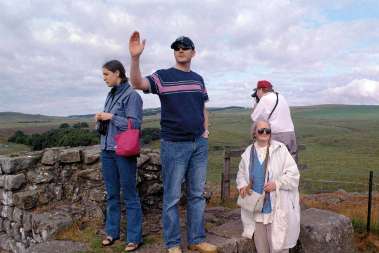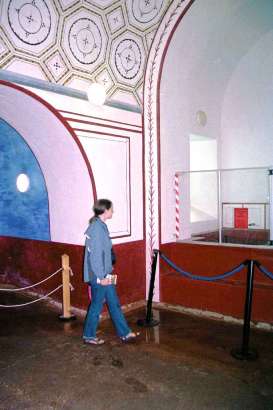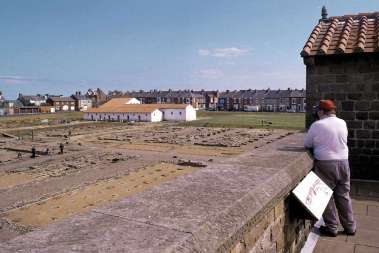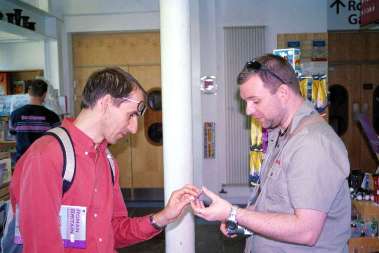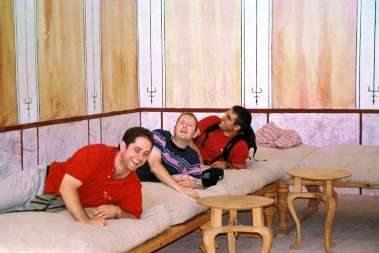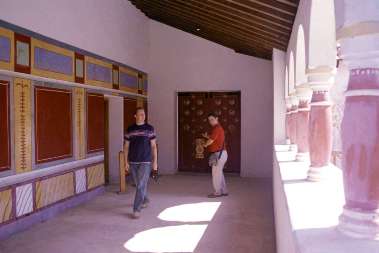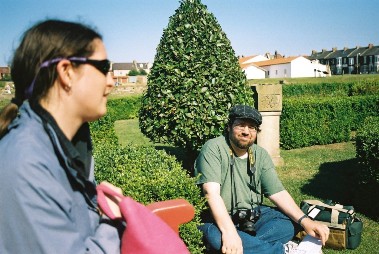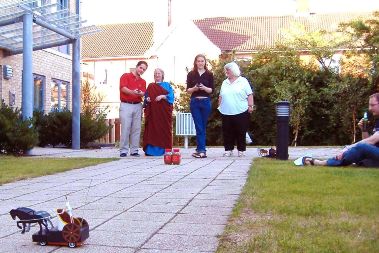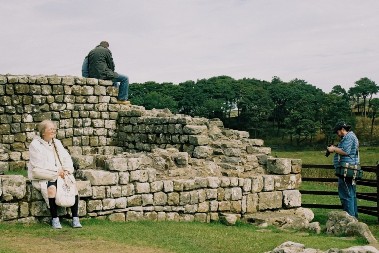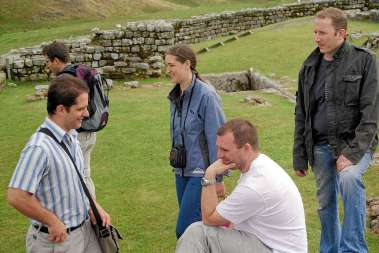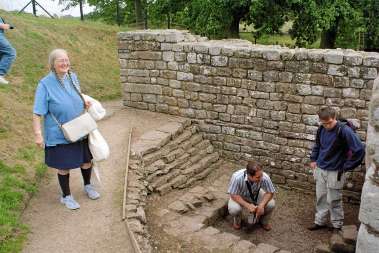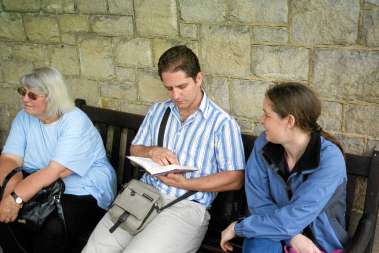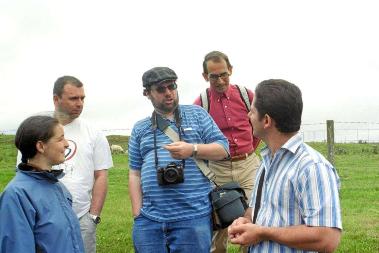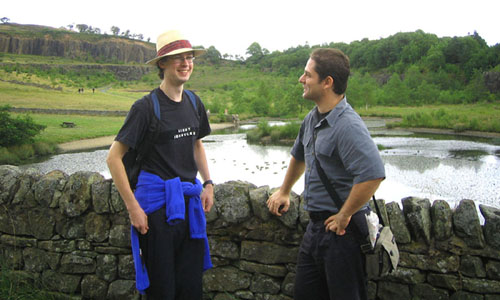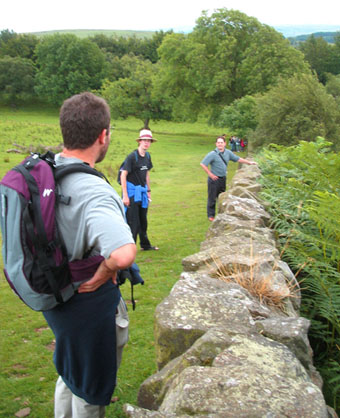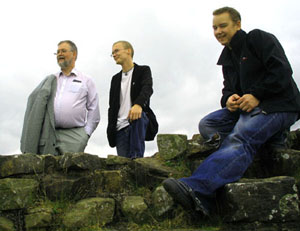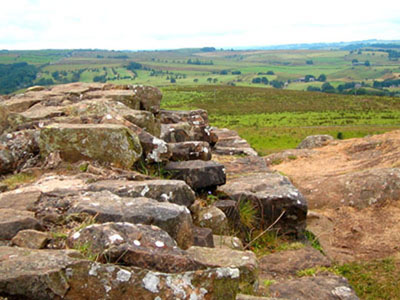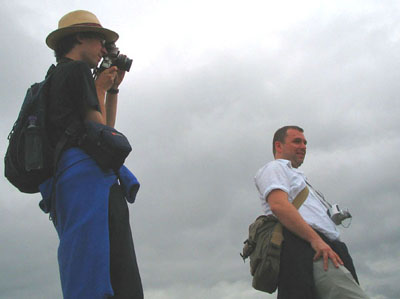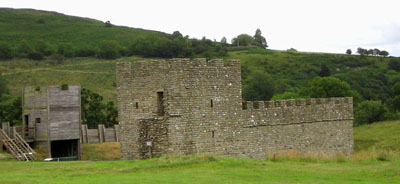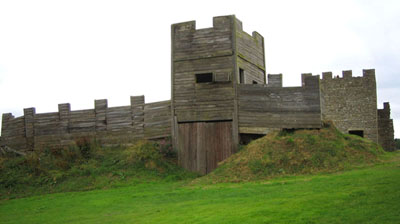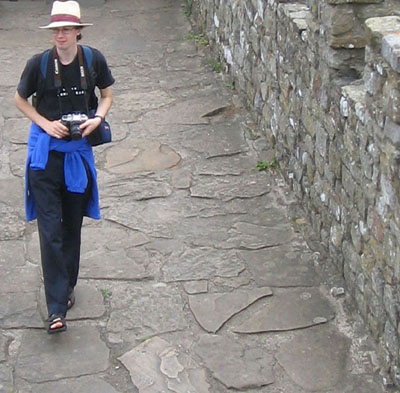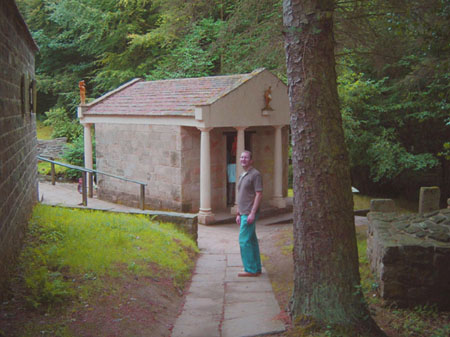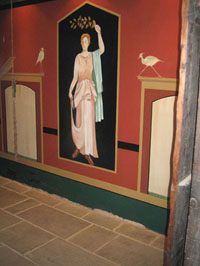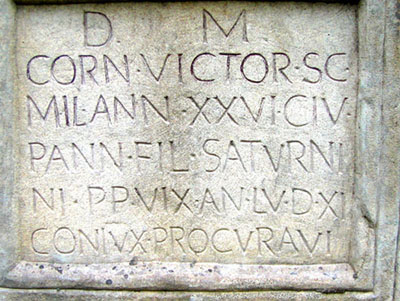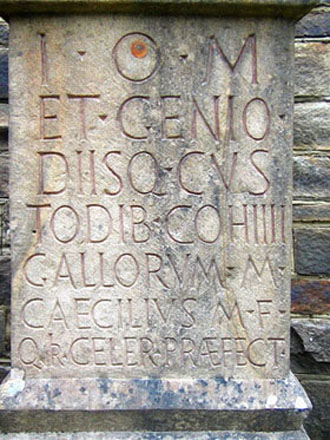V Conventus Novae Romae
The fifth annual Conventus Novae Romae in Europa was held at Hadrian's Wall in provincia Britannia between a. d. III Non. Sex. (Thursday the 3rd of August) and a. d. V Id. Sex. (Wednesday the 9th of August) K. Buteone Po. Minucia cos. ‡ MMDCCLIX a.u.c..
Hadrian's Wall
Hadrian's Wall was unique in the Roman world and remains one of the most outstanding historical sites in Europe. It was designated a World Heritage Site almost twenty years ago.
The Wall was built in the early second century C.E. on the orders of the emperor Hadrian, who spent much of his reign touring the frontiers of the empire and who visited Britain M'. Aviola C. Cornelio cos.‡ (DCCCLXXV a.u.c.). Running some 80 Roman miles from the Irish Sea to the North Sea, the Wall marked the northernmost frontier of the Roman empire.
It is a remarkable feat of Roman engineering, originally about six metres high and between two and three metres deep, and much of it still stands. It has been suggested that Hadrian was inspired by stories of the Great Wall of China brought back by travelling merchants.
More information on Hadrian's Wall
Carlisle
The Conventus was based in the city of Carlisle in north-west England, which itself began as a settlement around the Wall fort of Luguvalium. Carlisle has had a turbulent history under the Romans, Celts, Saxons and Vikings. It gained city status during the Middle Ages and during the 14th to 17th centuries was constantly involved in the feuds and bloodthirsty raids of the Border Reivers that took place over the disputed lands between England and Scotland. It has associations with some of the most striking characters of British history, including King Arthur, Mary Queen of Scots, Bonnie Prince Charlie and Queen Victoria.
Carlisle has many fascinating historical buildings to visit, but it is also a dynamic modern town with speciality shops, theatres and entertainment centres. It is large enough to be vibrant, but small enough to explore on foot. It has a fine museum of Roman and other antiquities.
Accommodation
Guests were accommodated at St Martin's College. This was a modern block normally used as student lodgings, built M. Octavio L. Sulla (II) cos. ‡ MMDCCLV a.u.c.. Each room had its own bathroom. Rooms were grouped into flats of five to eight rooms, and each flat had a shared fully-fitted kitchen and dining area. The Conventus party occupied two floors of one building, and many of the communal activities (including breakfast and, except when eaten at a restaurant, dinner) took place in the kitchen of the downstairs flat.
The Guests
Present at the Conventus were:
| T. Amatius Paulus (citizen of Hispania) - Read his recollections of the Conventus | A. Apollonius Cordus (legatus of Britannia) - Read his recollections of the Conventus | K. Fabius Buteo Quintilianus (citizen of Thule) - Read his recollections of the Conventus | |||
| Q. Fabius Pictor (probationary citizen of Thule) - Read his recollections of the Conventus | C. Flavia Aureliana (citizen of Britannia, wife of Michael) - Read her recollections of the Conventus | D. Gladius Lupus (propraetor of Hibernia) - Read his recollections of the Conventus | |||
| C. Livia (propraetrix of Britannia) - Read her recollections of the Conventus | P. Memmius Albucius (Gallia - Leg. Lugdunenis - former Tribune) - Read his recollections of the Conventus | V. Minucius Falco (citizen of Thule) - Read his recollections of the Conventus | |||
| Gal. Minucius Iovinus (legatus of Thule) - Read his recollections of the Conventus | C. Moravius Laureatus Armoricus (legatus of Britannia) - Read his recollections of the Conventus | M. Octavius Germanicus (citizen of Lacus Magni) - Read his recollections of the Conventus | |||
| Cn. Salvius Astur (citizen of Hispania) - Read his recollections of the Conventus | Michael Schofield (peregrinus, husband of Aureliana) - Read his recollections of the Conventus | A. Tullia Scholastica (citizen of America Mediatlantica) - Read her recollections of the Conventus |
The Conventus
Day 1
a.d. III Non Sext. ‡ (Thursday 3rd August)
Astur, Paulus, and Cordus travelled together by train to Carlisle and arrived in the mid-morning. They checked in at St Martin's and then walked to a pub for lunch. Meanwhile Scholastica's flight, due around 10:00, was badly delayed, and didn't arrive in Manchester until lunchtime. There she was met by Aureliana and Michael. As the three of them drove to Carlisle, Astur and Paulus were having a meridiatio back at St Martin's, while Cordus sat outside in the sunshine perusing his Roman cookery books.
After a little while Astur joined Cordus in the courtyard. Unknown to them, Lupus had now also arrived at St Martin's, and came outside just at the same moment that Aureliana, Michael, and Scholastica arrived from the other direction. After exchanging greetings, everyone helped to bring the food and drink from the cars to the ground-floor kitchen. Lupus, Astur, and Paulus spent some time wrestling with the two refrigerators to get them working, with eventual success.
The remainder of the afternoon was spent in the kitchen, chatting about various things. Paulus and Astur told everyone about their recent successes with the legio VIIII Hispana and about their legionary equipment, and Astur demonstrated his reconstruction of the rules of the ludus latrunculorum.
In the evening the company walked into Carlisle for a very pleasant dinner at a restaurant called the Lemon Lounge, and afterward returned to St Martin's for a little further idle chat before retiring to bed.
Day 2
prid. Non. Sext. ‡ (Friday 4th August)
After breakfast in the kitchen, the group gathered at 10:30 to head into Carlisle. After walking around the city centre they visited the Cathedral, noting the many unusual architectural features which are the result of several successive extensions.
They went on to the Tullie House Museum, where (after lunch at the museum café) Astur and Paulus, both members of the legio VIIII Hispana, were particularly interested in the Roman military artefacts and reconstructions, including the reconstructed cavalry saddle. Also on display was a reconstructed wax writing-tablet, which Cordus used to demonstrate Roman cursive script.
Meanwhile Michael, feeling mischievous, encouraged other members of the group to experience the museum's reconstruction of an old lead-mine such as might have existed in Roman times. What he didn't tell anyone was that the tunnel got lower as it went on, and those who had entered more or less upright emerged at the other end on hands and knees and looking not entirely amused.
Having thoroughly explored the Roman section of the museum, most of the group watched the video presentation about Carlisle’s border reivers during the 15th to 17th centuries, while Paulus indulged his professional interest in the geological gallery. Michael, Aureliana, and Scholastica then headed back into the town centre to check Scholastica’s travel arrangements at the railways station. Paulus, Astur, Cordus, and Lupus set off to visit Carlisle castle but, finding that there was a charge for entry, decided to admire it from the outside before returning to St Martin’s.
When everyone had returned to St Martin’s, where Cordus gave an informal lecture on the possible reasons for the construction of Hadrian’s Wall, followed by a general discussion. This was followed by an unscheduled seminar on Roman handwriting, prompted by the writing-tablet in the museum earlier that day; and then Astur explained his recent work reconstructing the rules of the ludus latrunculorum, a popular Roman board-game.
In the late afternoon Laureatus arrived, soon followed by the party from Thule: Buteo, Jovinus, Falco, and Pictor. Once they had unpacked and settled in, it was time for some food, and the group walked into the town centre (except for Michael, who preferred an early night). After a little searching, they found a trendy Indian restaurant called Teza (where Astur was surprised to fall into conversation in Spanish with the Indo-Portuguese waiter!).
After an enjoyable meal they returned to St Martin’s. Some went to bed immediately, others stayed up chatting for a while. The conversation was finally interrupted by a spider which both Astur and Jovinus declared to be of monstrous proportions until Cordus explained that it was a fairly normal size for a British spider.
Day 3
Non. Sext. ‡ (Saturday 5th August)
A new guest sat down for breakfast: Albucius had arrived late the previous night, and now made himself known. After breakfast the party assembled at the appointed place for the trip to the Roman Army Museum and Vindolanda, though not before Michael took some photographs for the Academia Thule website.
The Thulei made their own way to the museum in one car, while the rest of the party formed a convoy of three cars. The convoy had a little trouble finding the place and arrived somewhat after the Thulean car, but the schedule was not too much disrupted by a late start at the museum. A particular highlight of the museum visit was the impressive video presentation of Hadrian’s Wall, using computer graphics to show what the Wall and its forts were like in Roman times. There were also, of course, transcriptions of the famous Vindolanda tablets, and a video explaining how they were recovered and transcribed.
After lunch at the museum’s café (where a sharp-eyed Michael recognized another visitor to the museum as the geophysics expert from British archaeological television series Time Team), most of the group made the short but steep walk up to the well-preserved stretch of Hadrian’s Wall on Walltown Crags, while Scholastica, Michael, and Aureliana took a longer look at the museum.
Regrouping, the party then set off once more in its various vehicles to the fort of Vindolanda, a little south of the Wall itself. The Britanni had had a provincial meeting here the previous spring, but were impressed by the progress which the archaeologists had made since then; and the whole group enjoyed exploring the reconstructed section of Wall with its tower.
Paulus also befriended a horse in a neighbouring field, and Albucius and Laureatus examined with interest the inscriptions on a collection of altars, later joined by Astur, Paulus, and eventually also by Scholastica, Buteo, Jovinus, Pictor, and Falco. Meanwhile Lupus, Aureliana, and Michael relaxed on the patio outside the gift shop, joined after a little while by Cordus.
The Thulei took their leave, with a gracious speech by Buteo, and set off to continue their tour of the castles, golf-courses, and distilleries of Scotland; and the rest of the party returned to St Martin’s. There, after a little rest and relaxation, they convened in a small lecture room to watch the classic film "A Funny Thing Happened On The Way To The Forum" on the big(ish) screen. During the film Livia arrived, just in time for the take-away pizza which followed; and Laureatus began to show those who were interested how to play the board-game "Republic of Rome".
More information on Vindolanda and the Roman Army Museum
The online catalogue of the Vindolanda tablets
Day 4
a.d. VIII Id. Sext. ‡ (Sunday 6th August)
It is traditional at the annual Conventus to set aside one day for a general meeting at which guests can wear their Roman clothes (though of course they are free to do this at other times as well!) and share their thoughts and aspirations relating to Nova Roma. For educational value and a sense of gravitas, the meeting was conducted in the form of a meeting of the senate, according to ancient procedures; the meeting formed the main activity of the day.
After breakfast (cold pizza for Astur and Lupus, cereal or toast for the others), Livia gathered a small but dedicated band of volunteers to cook a Roman meal for that evening’s dinner. Once the menu had been decided, with the help of “Roman Cookery” by Mark Grant and “Around The Roman Table” by Patrick Faas, Livia and Laureatus went into town to buy the ingredients, while some of the others changed into Roman clothes. Cordus gave everyone a brief explanation of the rules of procedure in the Roman senate, in preparation for the meeting that afternoon.
Lupus, Aureliana, and Michael, deciding to skip the senate-meeting, had by this time already set off for a trip to the Roman coastal fort at Maryport. The Senhouse Museum, adjacent to the fort at Maryport, houses one of the finest collections of military altars and tombstone inscriptions in the country. Among many interesting objects, they found what appeared to be a stone gaming board, etched with diamond shapes rather than squares, which seemed to add weight to Astur's suggestion that diagonal moves could be made when playing Ludus Latrunculorum.
Meanwhile Octavius had arrived, and soon afterwards he, Astur, Paulus, Livia, Laureatus, Albucius, and Cordus went for a pub lunch in the town centre; over lunch, those who were experienced in speaking Latin gave some tips to those who weren’t.
The three who had gone to Maryport returned to find that in fact they hadn’t missed the meeting of the senate at all, which was promptly convened. Cordus, since he knew the procedures, took the role of the presiding consul. Octavius and Astur, who were in reality tribunus plebis and censor respectively, occupied those roles in the meeting also. The others were, for the sake of the exercise, assigned various ranks: Laureatus that of princeps senatus, Albucius that of consularis, Scholastica that of praetoria, Livia that of aedilicia, Aureliana that of tribunicia, and Lupus that of quaestorius (Paulus and Michael exempted themselves from the meeting). A table was used as the raised platform of the presiding magistrate, and Cordus sat on it while Octavius, representing all the current magistrates except the tribunes, did his best to arrange himself in a semi-circle in front of it. Astur occupied the long tribunician bench to one side of the platform, while the other senatores sat facing it.
Debate proceeded in an orderly manner, with occasional pauses to discuss procedure. The party was able to observe the effect of the senate’s rules of procedure on the conduct of the debate, in particular the rule that a sitting magistrate could speak at any time and for as long as he wished. The relatio was a broad one, de re publica, and many interesting suggestions for the better functioning of the republic were put forward. In the end Cordus presented two proposals for voting. One, formulated by Lupus, Albucius, and Astur, was that a one-day meeting should be organized every year during the weekend closest to the 21st of April in some easy-to-reach location such as Paris: this was unanimously approved. The second, proposed by Astur, was that "we should do fun things". This was passed by a majority, the only dissenting vote being, for unexplained reasons, Astur himself.
The rest of the afternoon was spent in various amusements, including some general discussion of topics which had arisen during the meeting, including especially the use of the wiki and its role in the future of Nova Roma. In due course Livia summoned her sous-chefs to the kitchen to begin the preparation of the Roman meal, and soon almost everyone was cooking, mixing, or chopping something or other. Laureatus was responsible for a magnificent psoai (pork in a tangy sauce with garum); Albucius produced a formidable aioli (a garlic puree with two whole heads of garlic!); Cordus mixed the dough for some lagana (a sort of fried pasta), which Albucius and Laureatus helped him to form into something like rectangles and which Livia fried; and everyone banded together to produce the rest of the menu: a dish of chopped mushroom stems; puls (a traditional Roman millet porridge); cucumeres (cucumbers, braised with vinegar and honey); and a mixtura cum caseo, a dip for the lagana, made using vegetables and cheese. For dessert there was itrion (honeyed sesame biscuits) and the old favourite "date surprise" (the surprise is that the dates have had their stones removed and replaced with almonds). The whole enterprise was made even more challenging by the fact that there were no measuring-jugs or weighing-scales to be found!
After the meal had been made, served, and eaten, Aureliana and Michael nobly undertook the epic task of washing up, while some guests sloped off to the upstairs kitchen. There a game of "Republic of Rome" now began in earnest, though the onset of night meant it had to be adjourned until the following day.
Day 5
a.d. VII Id. Sext. ‡ (Monday 7th August)
The company had early start on this day, meeting at nine o’clock to board the coach for Newcastle. On the way, they stopped off for a brief look at the fine milecastle at Cawfields.
The first of the main attractions was the fort and museum at Segedunum, with its observation tower giving an overview of the whole site. There was also the reconstructed bath-house, complete with reconstructed damp and musty smell; and a well-stocked shop selling books and other items.
Lunch was at the "Cave Bar", a bar and restaurant on the beach below a cliff, reached by a lift or a long flight of steps up the cliff. The next stop was Arbeia, another fort with more impressive reconstructions: a gate-house with towers, a barrack-house, and a very elegant house built around a courtyard.
The many rooms in the courtyard-house, brightly painted and filled with couches, tables, lararia, and the other accoutrements of Roman life, gave a vivid impression of civilian life on a military frontier. After the Roman dinner of the previous day, the guests were particularly interested to see the triclinium, with its large dining-couches and high ceiling.
After the week’s longest excursion many members of the party slept soundly on the coach on the way back, leaving Cordus and Astur to attempt a game of "I spy" in Latin; indeed, with five Latin-speakers among the company (Paulus, Cordus, Albucius, Astur, and Scholastica), there was at least a little Latin conversation every day.
Once back at St Martin’s, and after some rest, the party reconvened for the much-anticipated live chariot races. Sure enough, there were the chariots: remote-controlled cars covered with cardboard chariots hand-made by Cordus. They were taken out to the courtyard and given a few test-laps, which resulted in some last-minute improvements in the design (the chariots were tied on to the cars with string to stop them flying off on the turns). A circus was improvised with one meta (turning-post) marked by a bucket and the other by a pair of coffee-jars. Each contestant did a timed lap to establish the pecking-order, and the contestants were then matched against each other in pairs. These were followed by semi-finals, and at last the final match between Lupus and Paulus, with Lupus the victor. The two finalists were each awarded a Magna Mater t-shirt, kindly donated by aedilis curulis T. Julius Sabinus on behalf of the Magna Mater project.
Dinner was Chinese take-away this time, and in the evening the game of “Republic of Rome” continued, with the centres of power soon becoming clear: a triumvirate of Livia, Lupus, and Albucius struggling to overcome the hegemony of Paulus. Things took a strange turn when Paulus, already afflicted with a plague from Parthia, bankrupted himself in an effort to bribe an entirely unimpressive senator from Cordus’ entirely unimpressive faction, following the failure of that attempt by a threat of assassination! But the advance of time saved the hapless (though now wealthy) senator from his fate, as the players retired to bed.
Day 6
a.d. VI Id. Sext. ‡ (Tuesday 8th August)
The day began with another coach-trip, this time to the fort of Vercovicium. This impressive site, standing high on the dramatic crags which support much of Hadrian’s Wall, occupied the party for most of the morning. After exploring the site the company gathered, in twos and threes, standing and sitting, on the northern wall of the fort, looking out across the barbarian valley full of barbarian cattle.
They set off again by coach, arriving at Cilurnum just in time for an outdoor lunch at the site’s café. After lunch they roamed around the remains of the fort, eventually congregating at the bath-complex below the fort. There they variously peered into a well-preserved hypocaustum, fitted themselves into the alcoves in the changing-room, and relaxed on the grass. A quick visit to the museum followed, at which point Laureatus reluctantly said goodbye and headed off in his car for the long journey home. Astur, Cordus, and Albucius wrestled with a cryptic inscription on a Roman wedding-ring in the museum. Eventually everyone piled back onto the coach.
There was one more quick stop, to visit the well-preserved Mithraeum near the site of Brocolitia fort. Several members of the party tried to leave an offering of twenty pence on the altar, but this was promptly (and sacrilegiously) removed by a young boy belonging to another visiting party. After a quick conference, it was decided to make a formal dedication and to bury the offering in the ground behind the altar to stop it being stolen. Cordus donated a sestertius on behalf of the province of Britannia, and Astur, as pontifex, pronounced the necessary formulae. Satisfied, they group returned to St Martin’s.
Octavius (who had been due to leave the previous day but had managed to extend his stay for another day) and Albucius left by train in the late afternoon; the rest settled in for another film screening, this time the 1953 film of Shakespeare’s "Julius Caesar", with Marlon Brando, John Gielgud, and James Mason. For dinner the company sampled Britain’s national cuisine, an Indian take-away. The rest of the evening passed in idle conversation.
Day 7
a.d. V Id. Sext. ‡ (Wednesday 9th August)
At breakfast Cordus presented the remaining guests with their "certificates": it had been traditional at the Conventus for guests to be given a certificate commemorating their attendance, and in a spirit of provincial oneupmanship the province of Britannia each guest a wax writing-tablet inscribed with his or her name. Everyone was out of the rooms by 10:00, and Michael, Aureliana, Lupus, and Livia all set off for home.
Paulus, Astur, Scholastica, and Cordus headed into the town centre so that Scholastica and Paulus could check their e-mail at an internet café; then, after a Latin-speaking lunch at a little Italian restaurant near the station, they all squeezed into a train and headed for London. The Conventus was over... until the next year.
Guests' Recollections
T. Amatius Paulus
A. Apollonius Cordus
K. Fabius Buteo
Q. Fabius Pictor
C. Flavia Aureliana
This was my first Conventus and I had been looking forward to it for a long time. I wasn’t sure what to expect, or, indeed, what the others would be expecting. As part of the organising team, I was hoping that everyone would enjoy meeting up with other Nova Romans in an area of Britannia that has a rich Roman heritage and taking part in the activities we had arranged. As it turned out, I wasn’t to be disappointed with the way the Conventus progressed and I hope the others weren’t either.
I was particularly struck by the wonderfully friendly and relaxed atmosphere throughout our stay. Though I knew the other Britanni well and had met Astur before, there were several I did not know at all. However, this was not a problem and it is one of my outstanding memories that people from so many countries and backgrounds, with interests in so many different aspects of Roman culture could share their knowledge and experiences so amicably and animatedly for the length of the Conventus. We never ran out of topics of conversation - quite the opposite, time seemed to fly by - and everyone was eager to join in, whether it was a serious discussion about the meaning of an inscription or an impromptu rendition of an old Irish Drinking Song.
I think the accommodation at St Martin’s did a great deal to foster our sense of community. We made our own breakfasts in the community area adjoining one set of flats, so we could eat when we wanted and hang around chatting after we had finished. After the planned activities, we could all relax together in the same area and talk about what we had done and what we would be doing next. We didn’t have to worry about being a nuisance to other people or about having to "move on" if a bar or restaurant was going to close. We were a self contained little group and could set our own agendas. This freedom and informality allowed us to really get to know one another, but we could always take a break in our own rooms whenever we felt the need for a little privacy without being too far from the centre of things.
I enjoyed every aspect of the Conventus, so it is difficult to pick out one or two things as being better than others. All the sites we visited had their own particular point of interest be it the Eagle’s Eye film at the Roman Army Museum, the writing tablets of Vindolanda, the cavalry saddle at Tullie House, the altars at Senhouse, the dramatic views from Vercovicium, the reconstructed bath house at Segedunum or the well preserved one at Cilurnum. Even the mile castle at Cawfield gave a very good feel of what it must have been like to patrol the Wall.
I was particularly impressed by Arbeia, with its’ imposing reconstructed gateway and the dazzling commanding officer’s house and I was especially pleased that we found time to visit the Mithraeum near Cilurnum. The last time I had visited it (before some of our younger guests were born), it was an unmarked feature that had to be reached across a boggy stretch of moor land. I had been the only one there and found it to be wonderfully atmospheric. When I saw the large car park and dozens of tourists sauntering down a well constructed path, I felt it might have been a mistake to return, but I was wrong. Despite its popularity (and the activities of our irreverent young friend), it still felt special and I think it was very fitting place to visit as our final excursion.
The Roman Cookery Session and Meal was a high light of the Conventus. Everyone joined in the preparation with enthusiasm. I can’t claim to have done much of the actual cooking, but I did keep on top of the washing up. The food was delicious, especially Laureatus’ Psoai, though I wasn’t brave enough to sample the Aioli!
Cordus’ scheduling of the film "A Funny Thing Happened on the Way to the Forum" for the Saturday evening was just what was needed after a busy day’s sight-seeing. However, even this was surpassed by the fantastic chariot racing on the Monday. This was a truly inspired idea that got everyone totally involved and Cordus deserves special praise for his hard work in creating the chariots. While most people were proficient and some were exceptionally good at driving the chariots, I was utterly hopeless. Not only could I not get my chariot to turn round the meta, I couldn’t even get it to stop, which meant it either disappeared out of range or crashed into my opponent. Everyone, quite rightly, thought this was hilarious, but I have a feeling that if we had held the chariot races on the Friday, Astur wouldn’t have been so keen to let me drive him to Vindolanda on the Saturday!
I had a wonderful few days at the Conventus and was very sorry when it was over. If you were unable to attend, I hope hearing about our experiences will persuade you to go to the next one in Hispania. I can thoroughly recommend it.
===D. Gladius Lupus=== Salvete Omnes: I had the best time at the conventus, it was great to see some of the old faces again and to meet some new faces to go with the names. The wall itself was magnificent and for me it was a chance to make a tactile connection with our shared Roman heritage, to be able to see, touch, climb on and look out over the wall really gave an indication of what it must have been like back then (even if the wall is nowhere near as high as it used to be) a little bit of imagination goes a long way. I thought the cooking session was brilliant, here we had a diverse group of people, some of whom had never met before, working together (quite harmoniously) to prepare a proper feast, that turned out to be actually very tasty, that's what Nova Roma is all about, coming together to create for the whole to enjoy.
The evenings were good fun too, I remember doing quite well at the Republic of Rome game even though I had no clue about the voluminous rules and I seemed to completely miss the point of the game which I think was to make a grab for power and become the first man in Rome, it would seem that I have a seriously under-developed sense of ambition.I thought Cordus did us proud with his excellent chariots for the races, they were brilliant and the racing itself proved to be a lot of fun, and it was great to win, so if anybody out there is looking for someone to drive a team for them, you know who to call! All praise to Laureatus for his rapid organising skills too, that was the fastest I've ever seen racing qualifications organised.
The sites, forts and museums we visited were all amazing, they were well laid out and gave us a lot of information, I actually managed to track down a copy of Rudyard Kiplings 'A Roman Centurions song' that I'd seen on one of the walls in Tullie House museum. However I am sorry I missed out on the mass NR invasion of the Triclinium at Arbeia and I then ended up accidentally straying after the archaeologists into a cordoned off part of the site, luckily Paulus was there to call me back.
All praise goes to our friends of Provincia Britannia who looked after us all so well, who made sure everything went without a hitch,and had a well organised timetable that ensured we got the most out of our short time on the wall.I look forward to seeing everybody again in Merida next year, take care; Lupus.
C. Livia
P. Memmius Albucius
The antique Luguvalium (Carlisle) is now a modern city with respectable bricks houses and institutions,
Today, Laureatus and Aureliana are checking either their guests, the time to go to Vindolanda or all the
possible ways to drive there. Cordus and Scholastica are ready to join their mental forces (see picture, right).
We stop first at Wallton Crags. The place deserves its name. We have to walk in a pleasant track, full of jokes and conversations, in latin or in local language (see picture, below), and also full of flowers and butterflies. The track snakes along a quiet water, before driving us to the top of the hill, where the Wall is waiting for us.
There, after a little wooden cattle door, we have to reach the ridge, on our left. The clouds are fighting with the sun for ruling the sky.
On the way up, we understand
that the physical form is
not the same inside the
Legio Hispana :
as a tough vet centurion,
Paulus seems to think
"waiting for you, comrades! "
while Astur is holding
Hadrian's wall, fearing
that it might flee to Scotland (below left).
On the top of the hill, we are glad to meet, among a group of
young female tourists,
our friends from Thule, whose raedae
have been facter than us, and their maps better than ours.
(see picture, below).
We are now all watching in front of us, downhill, to the North, thinking to the feelings
that roman troops could have, 1,800 years before, when watching Selgovae,
Votadini and other Caledonian warriors coming to them.
The wall is here at our feet, thick, impressing, commanding the whole landscape
around us (see picture, right below).
A few pictures later (see picture, below right), we left Wallton Crags for
Chesterholm, ancient Vindolanda.
At this time, it is interesting to note that, except the settlements that they have created ex nihilo, Romans have been clever enough not to change the names of the places, villages, towns of the countries that they have invaded and occupied.
We have seen, for example, that Carlisle was called "Luguvalium" and Chesterholm "Vindolanda". Both names come from the celtic language, which was common to the most part of Europe at Republican times. Luguvalium is a latin interpretation of "Lugu-ialon" which means "place/settlement of Lug". Lug was one of the main celtic gods, the equivalent of Apollo. In the same mood, the french modern city of Lyon has ingerited its name from celtic/gallic "Lug-dunum" (i.e. the fortress of Lug).
Vindolanda meant "white moor". This observation is not an exception : we may verifiy this phenomenon all around Romanised Europe.
Vindolanda was a key position in the defence against northern peoples.
It is not "on" Hadrian's wall, but a few kilometers south, roughly in the middle of the length of the wall crossing England. Before the wall, the place had already welcome several forts. Vindolanda is, close to the roman fort, the most extensive civil settlement to be seen in whole Britain. It was first built in the middle of the 2nd century and was occupied, with a short break, until the late 3rd century.
Once the civil settlement visited, you are attracted by a full-scale reconstruction of a turret and lenght of the Wall, at you left.
This was the south gate of early fort.
(see pictures, below, left and right).
We may still find
roman local soldiers
surveying the limes
(see picture right below).
We have visited the remains of the roman fort,
and have walked down in direction of the museum.
Here appears first a reconstituted temple,
that shows me Laureatus
(see picture below, left).
The inner paintings have been recreated too,
even if today's painter, perhaps true to the genuine composition,
seems not having the same skills than Pompei's artists.
(see picture far right below).
After the temple a romantic little bridge take us to the museum. Before the museum, a wall with two roman inscriptions. With Laureatus, we are approaching them, soon joined by Paulus and Astur (see Cordus pictures). We succeed at last decrypting these interesting writings. If you, honorable reader, are interested in this hardwork, please have a look on the article in the following page : http://www.crystalwebvision.com/aedil/albucius.htm. And I let you try to translate the other inscriptio, Caecilius's one.
V. Minucius Falco
Gal. Minucius Iovinus
C. Moravius Laureatus
M. Octavius Germanicus
Cn. Salvius Astur
This conventus really fulfilled my expectations. Not only were we able to see several impressive Roman sites - I was particularly delighted to see some of the reconstructions of towers, gates and walls, both wooden and stone-made, that helped to get a very good idea of how Roman fortifications looked like, and to see the marvelously preserved mithraeum - but, more importantly, we had the chance to spend a lot of time with other citizens; something that, for me, is the real objective of these meetings.
The accomodations at St. Martin's were quite good. Common rooms allowed us to interact with each other almost 24 hours a day, while at the same time being on our own. In all the meetings I have had with other Romans, rarely have we had such a high degree of autonomy - and it is really worth having it.
The Britanni did an impressive job in arranging everything. Not only the accomodations were excellent, but the excursions were well selected, interesting and worth seeing. The activities planned were also very good.
The only bad thing that I can think of about the conventus is that it is over. I hope to be able to see many of the same participants in next year's conventus in Hispania. I certainly plan to stea... er... adopt some of the ideas and concepts I have seen this year in Britannia about what a conventus should be.
Michael Schofield
Memories are associated with emotions here are some of mine:
Excitement
Seven days devoted to Roman interests from 3rd August to 9th August, this was part of my annual leave. I had an idea of the schedule of forthcoming events.
Apprehension
Would the weather be kind? We had experienced outstanding heat wave conditions prior to arrival at Carlisle, with a high weather front dominating for several weeks, bringing drought conditions to some parts of the country. Usually this is followed by several weeks of continued rain as westerly low pressure dominates. Luck prevailed and mixed mild weather (mostly dry) settled in for our stay.
We worried over individuals arriving safely at St Martin’s College from over seas, who had to make several connecting flights and rail journeys.
Disappointment
The Conventus was planned to accommodate an unspecified number of people at St Martin’s College. Original interest via the Web site didn’t translate through to attendees and the scaling of facilities and coach travel had to be adjusted accordingly.
I am certain the content of the holiday would have provided stimulating conversation and a good opportunity to meet old and new friends for all.
The Swedish contingent only saw a ‘Snap Shot’ in my opinion of the whole holiday. I would have liked the pleasure of their company for longer; maybe some other time and place? Britannia has a lot to offer!!
Gratitude
For the friendly and like minded company; who made sure this was a successful interesting occasion.
St Martin’s College for comfortable affordable accommodation provided. The accommodation gave privacy for the individual (No shared rooms), providing other facilities on site, such as a DVD, projector and lecture room, Refectory, gymnasium, laundry room etc. Shared communal kitchen and meeting area. They are exceptionally flexible, friendly people.
A. Tullia Scholastica
Links
The publicity page for the Conventus, originally housed in this namespace.Historical Pages > Historical Pages
Master Index > English > Nova Roma > Civic life (Nova Roma) > Events for Romans
Master Index > English > Nova Roma > Res publica (Nova Roma) > Magistracies (Nova Roma) > Magistrates (Nova Roma)
Master Index > English > Nova Roma > Res publica (Nova Roma) > Provinciae (Nova Roma) > Provincia Britannia (Nova Roma)
Master Index > Maintenance Categories
Master Index > Maintenance Categories
Master Index > Maintenance Categories
Master Index > Maintenance Categories > Pages needing translation (Latin)
Master Index > Maintenance Categories > Pages to be deleted > Pages needing translation (French)
Master Index > Maintenance Categories > Pages to be deleted > Pages needing translation (German)
Master Index > Maintenance Categories > Pages to be deleted > Pages needing translation (Italian)
Master Index > Maintenance Categories > Pages to be deleted > V Conventus Novae Romae
Provinciae (Nova Roma)
